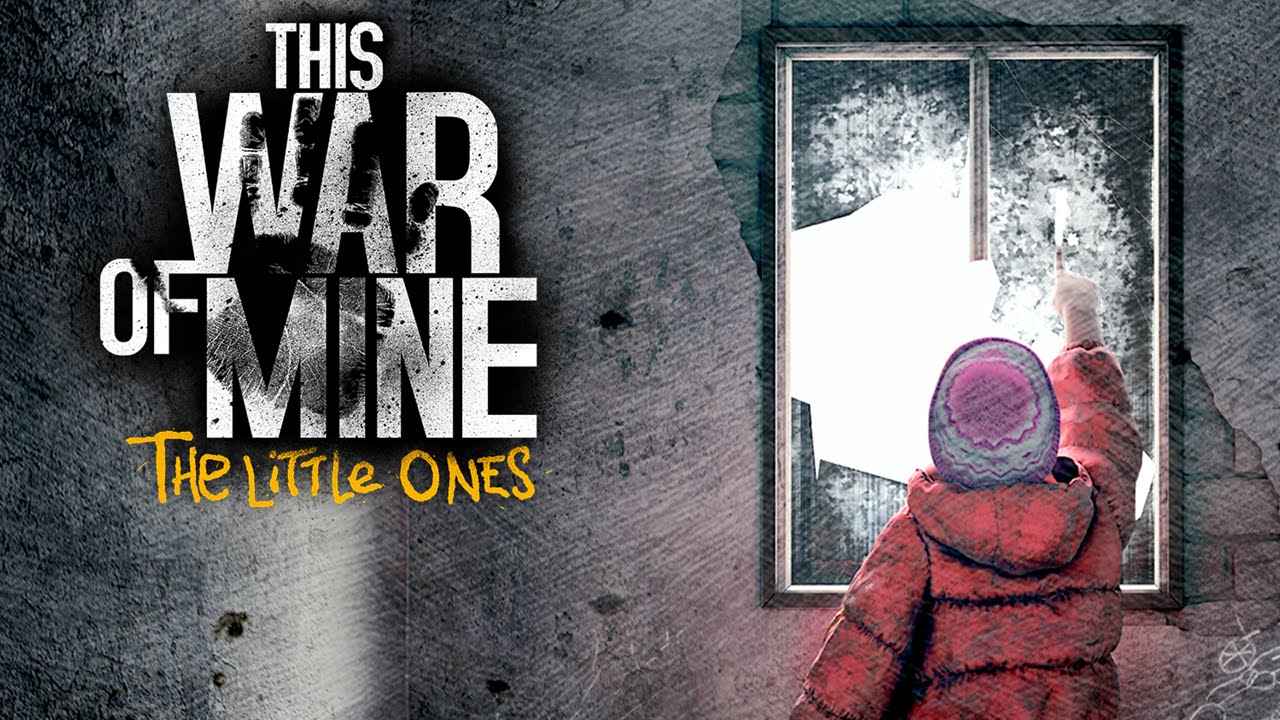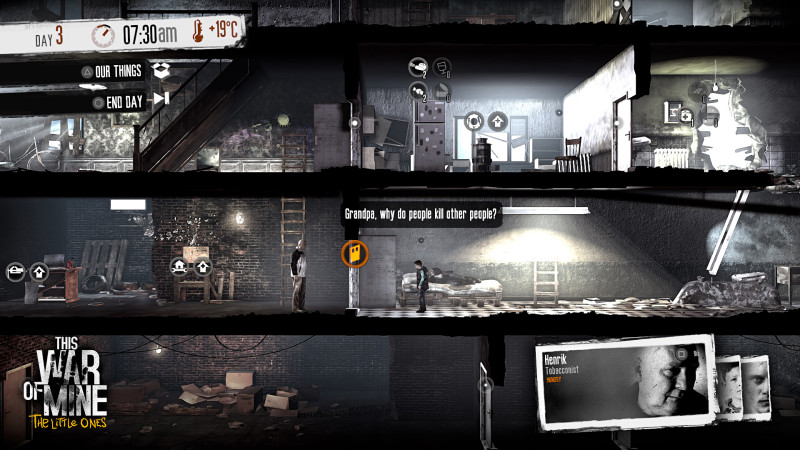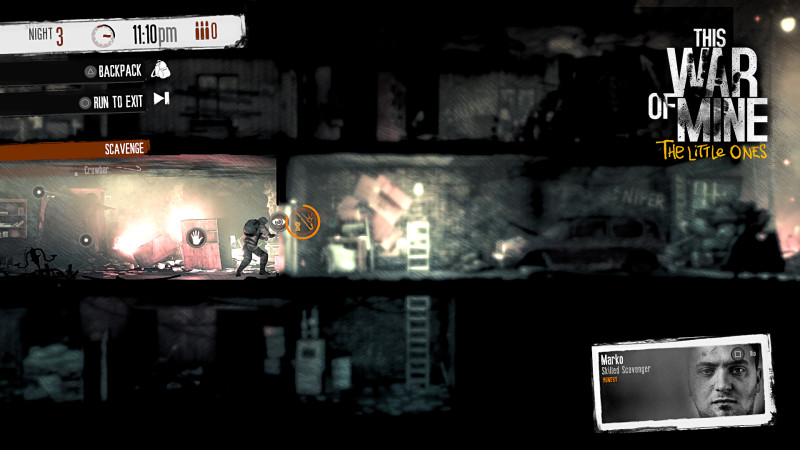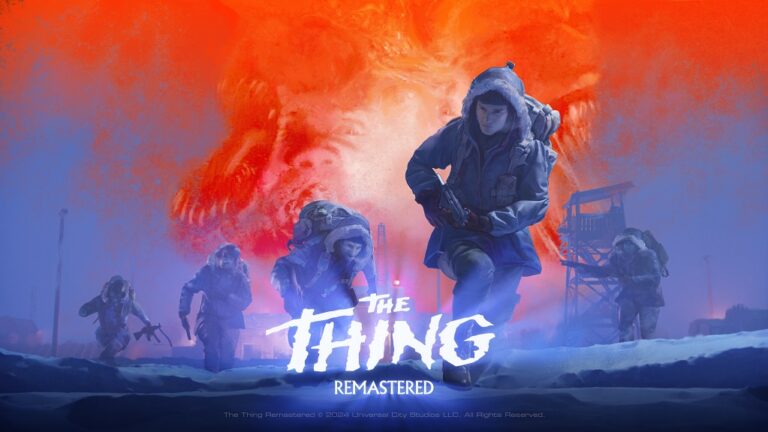
This War Of Mine: The Little Ones is the console release of the game of the same name which released on Steam in 2014. This is a survival sim which drops the digital lives of three characters into your hands – asking you to help them survive in war-torn city until there’s finally a ceasefire which marks the end of the war, and the end of the game. Until then, you and your survivors will face many hardships, from simple matters like having to dig through piles of rubble for scraps, to deciding to steal or commit atrocities, all the while knowing others will attempt to do the same to you. Sometimes you’ll need a special tool to get through a door or clear some rubble, most of which are breakable or one-use. If you need a simple descriptor for the game, think Don’t Starve meets The Last of Us (in aesthetic) with a bit of The Sims and you’re nearly there.
The console iteration of the game not only acts as a mere port of the original but adds children into the mix as a new gameplay element, joining both their naivety and fragility with their parents’ determination to keep them innocent and see them through the war. The game allows you to start with both a custom selection of characters and various other parameters such as the amount of days until the ceasefire or extent and intensity of winter. You can also allow the game to select these elements randomly for you; I decided to go with chance and picked this option for my first playthrough. Each character has a particular perk or skill as well as a potential addiction. I ended up with Bruno, who came with the ‘Good Cook’ skill, Katia who had ‘Bargaining skills’, and Pavle who was a fast runner. Bruno could hold fewer items when salvaging, therefore limiting his capacity to bring back found (or stolen) items. Bruno basically was assigned as a house husband, doing the cooking and building various contraptions when we could spare the parts.

During the day you can feed your people, build things with your materials and generally maintain your shelter and survivor’s well-being. By night. you can scavenge for parts, food, meds, etc. if you so wish. You can decide who leaves the safety of your shelter and who stays, as well as who sleeps and who guards. If you neglect to have anyone guard your shelter overnight, you could be subject to a raid where your supplies get stolen and/or someone gets injured.
Building things, and of course, maintaining your survivors both physically and mentally, is the main aim of the game. You do all this in the hope that everyone is still breathing when the ceasefire is delayed, which marks the end of that particular play-through. Finding and collecting parts is initially really fun – you can go looting, innocently scramble through piles and cupboards in abandoned houses or outright rob people at gunpoint. In the late game, however, I found that the best resources to focus on were wood for fuel and parts for making filters for water to then cook with, which stretches your ingredients a bit further and satiate your survivors for longer. Finding wood and miscellaneous parts gets tedious, and while there is a lot of different contraptions available to construct, these take the back seat when you need to start heating your shelter.
“In modern war you die like a dog for no good reason”. This is a fairly good representation of what the game’s theme is trying to get across. The theme here is that war is horrible, unfair and that it pushes people to and beyond their physical and emotional boundaries. There are a few moments in the game which get this message across quite well. In a battered shopping centre, for example, I came across a soldier preparing to presumably rape a young defenseless girl. He was heavily armed and all I had on me was a lockpick and a teddy bear, so I wasn’t sure what to do. Your behaviour and actions impact your character’s emotional state, which can range from ‘content’, where everything is peachy despite all of the death around them, to ‘broken’, which can potentially lead to suicide if left unchecked. Players are given the choice here to either react to the event or simply ignore it. There were lootable areas nearby so he was suitably distracted if one wanted to make the choice to quietly rummage, get a few bits and pieces and leave the area undetected. What the player makes the survivors do has an impact on everyone in the world around them. I decided to help this girl, though, not before I ran up the stairs and looted the place, just in case I had to flee. My intention was to peek through the keyhole to see what was going on… instead I accidentally heroically burst in through the door and drew his attention, then he raised his gun and started yelling, so I turned and ran as fast as the game allowed. This is where Pavle’s skill was especially useful. Running away from a horrible scene, but luckily it just so happened that I gave the young girl a chance to get away, and Pavle felt great about that. She didn’t join our group as I had expected but it lightened Pavle’s mood knowing that he helped someone.
Later on, Bruno became sick during the punishing winter phase and we had nothing of worth to trade for some medication. The game does a good job of using dire circumstance to drive you to do things which you usually wouldn’t unless pressed – so an option is always present to take what your survivors need by force from innocent people. This can lead to disaster as in my case Katia ended up killing them for it and later fell into depression soon after. When this happens, another character can talk them down to cheer them up, but if left alone, the other characters will harshly judge them. Pavle told Katia he’d never forget what she’d done as long as he lived. Brutal.

My first batch of characters lived for 35 days and died two days after winter ended, which was by far the most challenging part of the game. Pavle was stabbed to death, and Katia got shot and died in her bed. A new girl, Zlata, joined shortly after but fell ill at the same time as Bruno. Some items are extremely valuable for good reason, and good medication is a rarity, but it nets such a huge amount of resources it’s tempting to sell them when times are tough. Sadly, often times doing so will be a mistake. When a character becomes too sick they can’t leave the shelter to scavenge, so both Bruno and Zlata died in their beds, and it only took a few days to happen
These potentially difficult choices make up the entirety of This War Of Mine’s narrative. It doesn’t have a traditional plot, but that’s okay. It works well here and building your own story is interesting, especially as the characters are varied and each play-through can yield different results. Each character has a small bio and diary to log their thoughts as the day’s events unfold; this adds a nice bit of personality to the survivors and makes them more than just hollow Sims. The addition of children (which I didn’t see in my first playthrough) seemed to be an added hindrance to the game, though. The impact of their cheerful outlook on things slowly declining into depression or watching them get sick and trying to decide if they’re really worth saving is a thought provoking idea. However, from a gameplay perspective, they don’t add much, but it could be thought of as an extra addition to the narrative and the crushing weight of the game’s theme, as well as an extra difficult level for veterans of the original game’s Steam release. I didn’t feel much sympathy when my second play-through character’s daughter got sick because it was just another thing to worry about – the game is brutal enough, but he was so attached to her it dragged him down too much. For survival’s sake, it was in my best interests to keep her going without his child. Awful thinking, I know, but that’s the struggle. With the addition of children, there was also the challenge of having another mouth to feed. Despite their smaller stature, which could have proven potentially useful, children cannot venture into the night and scavenge. This makes them users and they contribute little other than perhaps giving some hope to the other survivors. The game does add craftable items that they or an adult can build in the form of toys, swing sets and so on to keep them active and combat their declining moods. Your choices will tear you between survival versus emotionally supporting a helpless child and their parent if they have one, which the game does so very efficiently.
Combat is finicky, and it is difficult to tell if things are unfairly balanced in the enemy’s favour because the player is representing a mere civilian, but losing a character to an unfairly balanced knife battle is a frustration in an otherwise fair game with harsh but well-defined rules.
Stealth sections are better balanced, as avoiding conflict is obviously less risky. These sections are genuinely tense and are pulled off excellently by other rooms behind a closed door or on a different level being blurred out and only red sound waves giving you an idea of where a potential threat might be coming from. Weapons are varied, from your bare fists to various guns, but to craft or maintain a gun is so resource-intensive that it’s usually more preferable to avoid conflict altogether, but this locks out a lot of areas and therefore many chances to scavenge.

Some characters’ addictions tend to rule them, or react depending on how often you feed them. Mostly, this was a mechanic I found to be irritating, but had a small overall impact. They made them whiny and the game already had plenty of things to manage. Bruno was a smoker, and it would get him down quite often if we ran out of cigarettes. Good quality smokes are a trading resource, so it was irritating knowing he would smoke our stash, especially when times got tough and he smoked like a chimney. In one instance, after Katia had got shot and started to bleed out, Bruno literally whined at her the second she came in the door. People have their vices, but come on.
The game mostly plays like a side-scroller but the controls, in general, feel a bit awkward. Side to side movement works well enough, controlling the item or action selection pop-ups is a bit cumbersome, but to go down a staircase, or not, was absolutely infuriating for ages. Due to the perspective of the viewing angle, I kept running up and down when I didn’t want to. Perhaps this was just a personal gripe and I’m just rubbish but one which plagued me for a while.
The repetitive nature of the latter half of my playthroughs hurt my drive to return, even though the custom setups do allow for plenty of replayability for those interested. Overall the game is enjoyable despite a few annoyances, and the inclusion of children didn’t really have the intended impact I assume the developers were going for. That said, the mood is definitely there and I spent some time thinking about the game when I had stopped playing. Hours escaped me as I rummaged through piles of junk, traded pills for some chicken and veg, built heaters, and fortified my shelter to defend against raiders. The art style and direction really works, and each environment is dark, beaten up and depressing. There’s barely a moment of solace, and it shows that the intention of this game is to constantly remind you that war isn’t just fought by soldiers. I felt something when Katia died as she was my main scavenger. She had lived so long and got so far. Knowing there’s no way to rewind your losses makes you feel sadness for a character, and their companions feel it too as everything from their emotional state to safety at night begins to spiral out of control. Fans of the survival and resource management genre will really enjoy this strong emotional element in This War of Mine: The Little Ones.
 (7 / 10)
(7 / 10)
 (7 / 10)
(7 / 10)
 furinb
furinb


